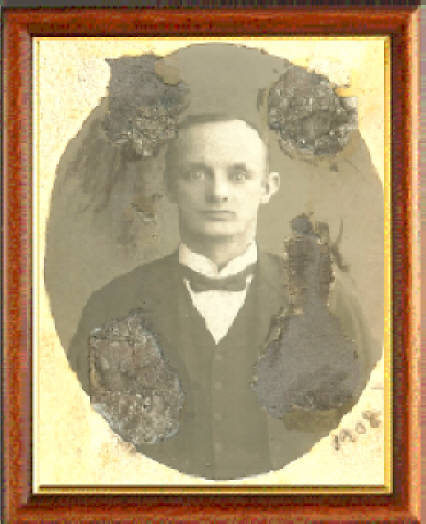

A SUBSTANTIAL AND INTRIGUING SHADOW
Behind the sailing clouds, the falling sun
Sends streams of light that patch the seas with blaze
Of shifting dull red gold a purple haze
Enwraps the many distant isles. The dun
Hills, clad in fragrant pine have now begun
To catch the sunset glow; athwart the rays,
The burdened coolie down the hillside ways
Hies slowly home ------- his daily toil is done.
The white wa' -mis call from rock and tree
In clear sweet notes of echoed rivalry;
Related pak-hoks come in stretching flight
Unto the darkening land, and, in the light
That swiftly wanes across the drowsy sea,
Their wings and bodies gleam a ghostly white
Thomas Kirkman Dealy
Hong Kong 1884-1918
His grave stone no longer exists but he still lies buried in the municipal cemetery in Grenoble in distant France. The frugal French re-allocated his burial plot to another later dead man who now lies on top and under a different grave stone. There are two records attesting to this. One is the official city record at the Hotel de Ville and the other is a photograph of the original gravestone. The latter shows Thomas Kirkman Dealy to have been born in 1860 and to have left this mortal coil 64 years later on 1 March 1924 just 6 days before the sixth anniversary of the death in the aircraft accident in Scotland of his youngest son. TKD had a consolation of sorts at least in being buried in the same country as his eldest son Frank who was also at rest in France some 400 miles to the north in the desolate war torn countryside of the Somme.
How was it that TKD ended up in France after so many years in Hong Kong? Why was it that his grave in the Catholic Cimitiere St Roch , Grenoble, was left unattended and forgotten for so long that the authorities deemed it not worth preserving?
TKD's early life has been hard to trace accurately. His Irish father (also Thomas) started life apparently in Dublin with the surname of Daly. Thomas migrated to England in his twenties and set up as a builder, master joiner meanwhile changing his name to Dealy and marrying Mehetabel Kirkman. I have not been able to establish whether Mehetabel was Irish too, but it seems she came from a landowning family in the north of England and I assume was a Roman Catholic like her suitor. Thomas senior became established in Sheffield and is reputed to have been responsible for building St Mary's Church amongst other buildings set up during the Victorian era. So it seems logical to conclude that TKD was born in Sheffield. His younger brother Henry Kirkman Dealy, evidently much less adventurously inclined, apparently lived his whole life in Sheffield establishing, in the Victorian tradition a large family to prove it.
Not so TKD…… much more intellectually inclined, his life took a very different course. Evidently good at languages (he became fluent in Russian, French, Cantonese as well as English) he achieved education sufficient to enable him somehow to win an appointment in 1884 at the age of 24 as a teacher to the Government Central School in Hong Kong. What his basic education was has been difficult to establish with any certainty. He is said to have won a scholarship to Durham University where he apparently took an honours degree, but unfortunately there appear to be no University records to substantiate that. However it is certain that he went on to become a FRGS (Fellow of the Royal Geographical Society), Fellow of the Educational Institute of Scotland (FEIS), Fellow of the Chemical Society (FCS) and DRF (Paris). He was appointed under the Secretary of State Despatch No 207 of 25 September 1884 and left London on the S.S. Glenavon (Captain Donaldson) arriving from Singapore after delays due to typhoons. He was at least a “Certificated Trained Master” since that was an essential requirement for the post of Assistant Master. Also stipulated was that the age for the post should not exceed 25 and that he was required to study Chinese. The records also confirm that before travelling to Hong Kong he had been Headmaster of St Mary's Catholic School Derby.
It is also certain that TKD was brought up as a Roman Catholic in the Irish tradition and that he maintained his faith throughout his life, though not without some turbulence and heart break. That early and ongoing adherence to his faith carried with it the seeds of tragedy and controversy that were to dog his own life and that of his immediate family through two generations.
At any rate TKD arrived in Hong Kong in December 1884 to take up the appointment of English Master in the Central Government School. He had actually taken up an appointment as an officer of the Hong Kong Civil Service in September 1884 to arrive three months later to take up his teaching post at the Government Central School.
The old Government Central School had its start in 1862 just 22 years before TKD took up his own appointment there. The foundation of the old school was itself barely 20 odd years after the British acquired Hong Kong Island in the early 1840's about the time when the Maori of New Zealand had negotiated the Treaty of Waitangi with the Victorians of that day and gold was discovered in California.
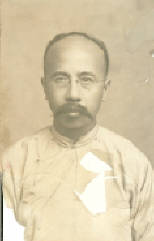
Hong Kong Island at the time it was established as a British trading post was quite undeveloped. There was only a tiny population of farmers and itinerant fishermen living in some small coastal villages. It was just one relatively small island amongst the many lying to the east of the Pearl River delta in the Southern provinces of the immense Chinese Empire. A place of little or no interest to the Chinese Manchus who thought little of parting with it following the Treaty of Nanking in the aftermath of the Opium Wars. The older Portuguese colony of Macao was regarded at that time of much greater import. Anyway, in 1840 the population of Hong Kong island was estimated in 1841 to be about 5500 people. Some of these tiny scattered villages had their own schools but these were small primitive places set up on the traditional lines of the old Chinese Government…the so called “Celestial Court” ruled by the Emperor of those times. In these schools learning was by rote in line with the long established Chinese tradition and the teachers were of course Chinese.
But these schools actually compared well with the equivalents in England itself where many school children in those years of the early Victorian era did their rudimentary lessons in wretched unsanitary hovels often under teachers untrained and ignorant of all but the most elementary knowledge. Like the Chinese children they learnt their lessons by heart without any explanation being given.
In the years between 1841 and 1862 the Colony experienced rapid development of trade, government institutions, population growth and some industry. The Government even in those early days introduced measures for the education of the young including support for missionary schools. In the years 1854-59 the number of children in Government assisted schools increased from just over 100 to over 800. The Government had also set up an Inspector of Schools and the Governor of the day Sir John Bowring brought the question of education to the front “ and there could be no going back”
The establishment of schools by the British for Chinese boys says something about the tremendous rate of progress in the development of the colony in those days as well as the desire of the colonialists to provide education for the locals to do “some good” for their future and that of the local people as well as for the colony itself.
The London Missionary Society was a major player in the provision of the early missionary schools in Hong Kong and a Dr Legge was a prominent and influential figure in the establishment of education in the colony. Surprisingly he was a strong advocate of secular education. Perhaps he took this pragmatic view as a result of the greater popularity of the secular Government assisted schools as opposed to the less well supported missionary schools. It was Dr. Legge who initiated the idea of a secular Government school with a headmaster recruited from England who would also have the task of supervising the aided schools outside the embryonic city of Victoria. The central school was to amalgamate the existing schools in the city. The demand for such a school came from the increased migration of main land Chinese folk a large proportion of which were from the better off bringing with them aspirations for the education of their children.
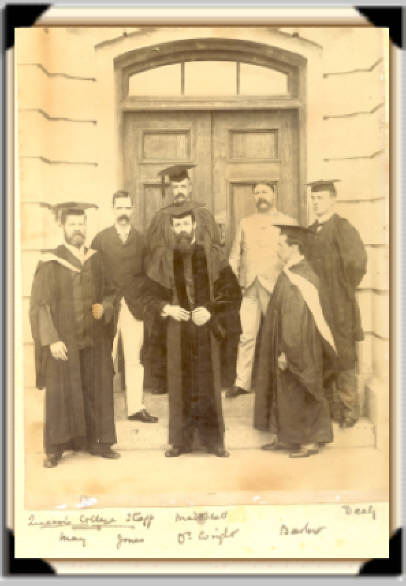

The new Central Government school was at first set up to admit only Chinese boys. Its first Headmaster was Dr. F Stewart, a Presbyterian. The overall hope was that the school would help to bridge the gulf between the Chinese and English. That in the long years that followed the gulf had largely been bridged is to an appreciable extent the result of the efforts of Dr Stewart and those that followed him at the Central school and its successor Queens College. No doubt in his 34 years of working for both establishments TKD would have contributed significantly to this result.
It is important to understand the situation and circumstances of those times in Hong Kong to appreciate the context within which TKD spent most of his working and married life. The way of life, the rules by which people lived were so very different from the way we live today over a century later.
When TKD arrived in Hong Kong the population on the island was not more than perhaps 50000 people. There was no organized transport system. People went about their business on foot, by horse or by sedan chair. (Insert photo) The latter consisted of two long wood poles to which was lashed in between a kind of box that provided seating for one person. Two coolies carried the contraption. Some of these sedan chairs were actually owned by individuals and the carriers wore a distinctive uniform and the chair itself might be ornately decorated with carved wood and curtains. But for the most part sedan chairs were for hire like modern day taxis though much slower and in a sense noisier (Chinese, at least those from the South of China apparently loved to make noise then as much as they do now).
China was going through the chaotic days of the dying Empire and was often in a state of turmoil. Famine, plagues, kidnappings, piracy were commonplace events as were the regular visits of the powerful typhoon storms that so often caused so much devastation in the colony (and still do).

.The gruesome photograph above was in my Grandmother's Box. It depicts the swift and brutal justice meted out in those days. The photograph was taken somewhere on Kowloon Peninsula, probably not long after the British had acquired that territory. It shows the bodies of 12 “Namoa Pirates” laid out in a row on the foreshore of a rather desolate bay. In the distant background across the bay are the steep hills of Kowloon mainland bare of anything except for scrubby trees and bush. In the middle distance are a few Sampans and a scattering of wooden buildings with what look like two telegraph poles. The decapitated heads of these pirates were laid more or less alongside their former owners' bodies. Behind the beheaded pirates are 8 Europeans and a Chinese peasant standing someway to one side. Near the wooden buildings can just be discerned a few knots of people. The Europeans are all well dressed 5 in some sort of white uniform two wearing white trousers and jackets of a dark material and one in a dark suit. Two of these men are wearing the sun topees that were a popular form of head dress in those colonial times sported by both the armed services and civilians as a protection against the sun. Six carried a walking stick of some sort and another carried a stick that doubled as an umbrella.
Whether this group of Europeans were just sight-seers out for a stroll or whether they were the ones who had been responsible for this awful scene is not clear. It is also not clear whether the death sentence imposed was the result of Chinese or British justice. At any rate each of the Europeans is clearly striking a pose and appears wanting to be associated with the evidence of the barbarity in front of them. The hands and feet of each of the victims were still bound….these bindings presumably had been placed to restrain them when held prisoner and for execution. The photograph is further evidence if such is needed of the cheapness of life in those days and of the gulf that lay between the colonials and the indigenous Chinese.
The Suez Canal had been open for 15 years by the time TKD took sea passage to Hong Kong so it is probable that his journey by sea was relatively short for those times. In the new age of steam ships the voyage however would still have taken four to five weeks. And that was a measure too of how long mail would have taken between the England and the outlandish burgeoning and relatively primitive colony of those days. The telegraph was still a new toy, radio, television, electric lighting, the internal combustion engine, aeroplanes and the telephone were things quite undreamt of in those days except possibly in the minds of their inventors.
By the 1880's the town of Victoria was well established with stone and wooden buildings and a sense of increasing permanence. But overcrowding and the consequence squalor, disease and occasional epidemics remained commonplace especially in the squatter areas near Victoria and in the villages. .
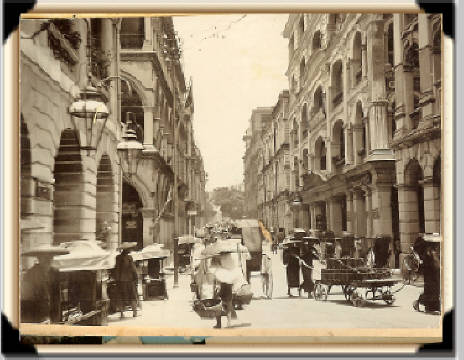
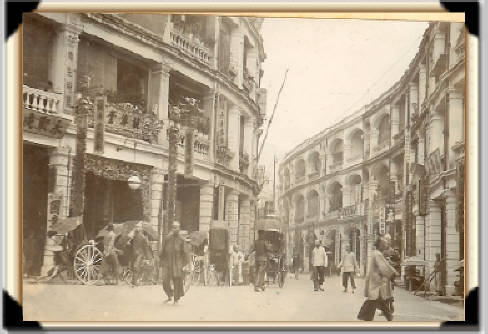
It is hard to imagine how teachers brought out from England had a hope of coping with Chinese boys who came to school knowing only their own Chinese vernacular language and that in many cases somewhat indifferently. The following extract from the history of Queens College (or the Central Government School as it was then when Dr Stewart first started as Headmaster) illustrates the problem very well.
Aged only 24 and knowing no Cantonese, the new Headmaster entered the school gates and found himself in a large hall occupied by some 300 students - some of whom were men -under the care of three Chinese masters. Of these 300 about half were from the so called Middle and Upper Bazaar Schools, some were intending applicants for the English classes and the rest were interested strays. Those who were authentic pupils were reciting Chinese lessons at a high pitch. As the young new Headmaster entered the voices rose higher. He, not understanding that this was an effort to please and impress him, remained non-plussed for a few seconds. Then he rose to the occasion and shouted “Silence”! This was taken by the boys as an exhortation to read louder. They complied willingly and 150 voices rose to an intolerable cacophony of noise. The young headmaster was forced to retreat “ almost in despair” to another and quieter place. Thereafter he applied himself to learn Cantonese as rapidly as possible because he knew as all his successors discovered after him that without the ability to speak Chinese he would fail.
"The Central School was first located almost in the middle of the rapidly growing city of Victoria on the lower slopes of the steep hills leading to the highest point of the island at Peak Hill. It consisted of just two one storied buildings joined by a small central hall. There was a single classroom in each wing. Three or more classes used these at the same time. The students ranged in age and status from mere boys to grown men. Several of the latter being married and supporting more than one wife or several concubines! Apparently there were no playing fields. Indeed the students were not interested in athletic endeavours. They posed as much as studied…they wore traditional Chinese garb - long gown, black caps and soft slippers and the majority, certainly all the older pupils wore the traditional queue. TKD writing of those days said “ When we hived and thrived in the old Central School there was not a single square inch of playground for the scholars.” Evidently the school was “ quite inadequate as regards size, insecure as regards its foundations and unhealthy as regards ventilation.” At that time each classroom accommodated about one hundred boys. So close did they sit that it was almost impossible for masters to detect who was cheating and the crowding together encouraged habits of dishonesty and deception…….!
In 1876 the school had 577 pupils enrolled - all were boys or grown young men. The emancipation of women had hardly begun and Chinese tradition still demanded that girls and women (at least in the wealthier classes) bind their feet and remain entirely subservient to the men in their confined lives. Land had been purchased for new premises higher up the hill on the steep slope of Aberdeen Street. But the new school premises were not to be built or occupied for another 12 years. In that time the Central School was subject of much controversy, one of the main issues being its secular character. The clergy of the European Churches in particular attacked the school as providing a “godless education”. The government however remained adamant that religious instruction was not practical. Whilst the Government was not opposed to such instruction it was simply impossible in a school of so many mixed nationalities. The controversy raged on however and was particularly stoked by the exponents of Roman Catholicism. The situation even went so far that the RC Church threatened its members with ex-communication if they sent their sons to the school!
Another controversy that rolled on for many years was not only about the extent to which the school should teach the English language. It was also about its effectiveness in teaching the language. In 1878 Headmaster Stewart in response to the Governor's order recorded that of the 453 pupils in the school 8 (mainly Europeans) spoke idiomatic English, 51 (33 Europeans and 18 Chinese) were reasonably fluent, 58 (all Chinese) spoke the language “with diffidence” and the remaining 336 “could not be said to speak the language at all”!
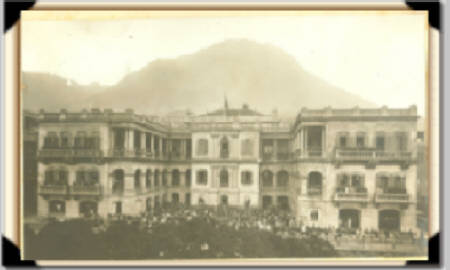
The school had begun to regularly achieve a name for itself especially through the success of its senior pupils in external examinations and the winning of scholarships. The examinations they sat for were set by Cambridge and Oxford. The school had developed to the point where there was a surprisingly wide range of subjects taught including English, English literature, (including Shakespeare), Reading and Grammar, Euclid, Trigonometry, Algebra, Translation from and to Chinese (of course) Latin, Mensuration, History “General Intelligence”, Geography and (for some) Scripture. It was not long after that biology, physics and chemistry were added to the curriculum…all this in a school that had only been established some twenty years earlier and taught mainly Chinese boys whose knowledge of English to begin with was, for most, nothing. The breadth of the curriculum and the achievement of its pupils speaks volumes for the skill, dedication and industry of the teaching staff. By the mid 1880's it was already established as the best school in the colony and it was to continue to build on this reputation and to maintain that position to the present day.
The move of the school into the new building took place in 1889. It was renamed Victoria College and was later to be renamed again (in 1894) as Queens College. The new building was certainly imposing and a great advance on the original squalid structures. When Victoria College opened its doors the staff consisted of nine overseas masters and ten Chinese Assistants of whom six had been trained through the old Central School. There were also three Chinese trainee teachers and four Chinese graduates on the staff but who spoke no English.
The new building was literally designed on the grand scale for those times and was certainly imposing. The “Old Lady of Aberdeen Street” as it was later to be called was the largest building in the colony barring the new City Hall. It was bounded by Hollywood Road and Aberdeen, Staunton and Shing Wong Streets on the steep slopes of Peak Hill above the clamour, bustle and commotion of the then lower parts of Victoria City. Its location was expected to provide relief from the overcrowding and noise that so blighted the old location. It boasted a basement and two above ground floors. It had a lead roof, granite monoliths and columns, and a large hall capable of seating 1000 people. It was designed to accommodate 770 pupils and there was enough land to provide for courtyards and playgrounds. But for all its grandeur (see photograph) the interior of the building was in places dank and gloomy. There was as yet no electricity and lighting was by gas. And it was not long (perhaps ten years or so) before the growth of Victoria City overtook the school and surrounded it again with the noise, squalor and commotion of business, trading activities overcrowding the road and streets bounding the College.
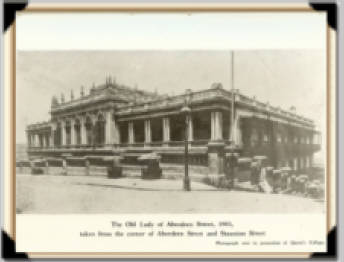
TKD was still a single man when the school moved to its new building. But he had established himself well and evidently won the trust of his Headmaster and employers to the point where he was appointed acting Second Master when the Head went on leave in 1891. But how and where he lived during those first years at the College is not on record. It may be that the Government provided separate quarters for its single male staff. Being a strict practicing Roman Catholic he no doubt would have maintained his links with his Church and worshipped at the RC Cathedral. He would also have made contacts within the ever-growing population of British expatriates.
Colonial society then was already highly structured. At the top of the pecking order would have been the Governor and the senior people of his administration and their families. So too would have been the senior people and owners of the burgeoning business and trading houses. The pecking order was reflected in the places where people chose to live or were allocated living quarters. The top most people resided in the mansions at or near the top of the Peak Hill on the Island. The ridge and high ground falling away from Peak Hill to Magazine Gap were also much sought after by the top echelons of the colonial society of those days. Of course apart from the prominence and exclusiveness offered by the high ground there were also other good reasons for wanting to live high above Victoria City.….. the altitude, such as it was, offered some relief from the heat, humidity, crowded conditions, disease and squalor of the lower edges of the Island. The high ground made it easy for the expatriates to keep themselves apart and distant from the Chinese population. Inhabitants of the high ground were also not only well away from the increasingly overcrowded, smelly, and dirty City but also had some protection from rampant disease and the relatively frequent outbreaks of epidemics like typhus, cholera and the bubonic plague.
So TKD most probably lived somewhere in accommodation on the Peak, but he may have had single quarters in the school itself. It is certain that in later years he bought one part of a large house above Magazine Gap. A place called Craigmin East. Whether that was before he married or after is not known, but the fact that he was able to buy it says something about the level of his overall income. His salary as a Government Civil Servant could not have been very high…it is not in the nature of Governments to be particularly generous, especially to relatively junior staff. So it may be that he earned other income from activities outside of school or he already had private income of his own. He would have had the time for doing other work as the actual school hours in those days would not have been demanding and there were also many public holidays and opportunities for local and home leave. At any rate he appears to have done well as far as money was concerned and managed over the many years he spent in Hong Kong to accumulate a reasonable fortune in property (his house) and stocks and shares.
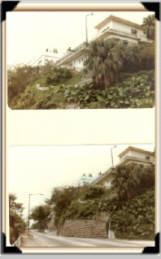
During the ten years before he married, TKD established a wide circle of friends and contacts in both the small population of ex-patriates as well as local Chinese. Amongst the former he made friends with Arthur Ough. Arthur worked for the British consulting firm of Danby and Leigh …… as a Civil Engineer and architect. Arthur spent many years in Hong Kong and was involved in many of the large civil engineering works of the time including the establishment of the new Hong Kong Canton (Ghuangsou) railway and some of the buildings of Hong Kong University. The Juror's Lists at the turn of the century showed AHO's name and as a resident of 53 Peel Street for the years 1889-1890 with the qualification of Architect. Oddly the record also shows him as taking part in a Christmas Pantomime and playing as second violin! Later lists show him as an Authorized Architect with the firm of Leigh and Orange and resident somewhere on The Peak near Magazine Gap. He appears to have lived and worked in Hong Kong for most of the period 1902-1912. During that time AHO became a father - Norman Ough his eldest son was born in Wanstead Essex on 15 February 1907, just 12 days after Margaret Mary Dealy was born in Hong Kong.
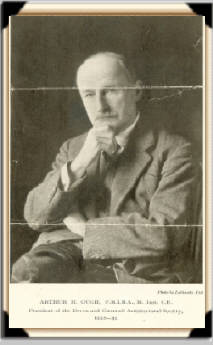
Arthur was the eldest son (born 1863) of Henry and Anna Ough who had eight other children. Five survived to adulthood and ripe old age - Eleanor, Marion, Anna Margaret (May), Sydney and Amy. It seems that Arthur was responsible, whilst in Hong Kong for showing TKD a photograph of his younger sister Anna May Ough. It was thius photograph that is said to have sparked TKD into action!
TKD took leave of absence for three periods between 1891 and 1893. - three months in 1891, 12 months in 1892 and four months in 1893. He spent much of these leaves in the UK and met with the Ough family to begin and complete his courtship. No doubt there was ample time to do that and the result of the generous leave allowances available to colonial civil servants in those days. But his long leave entitlements could have been accumulated over the preceding years when he probably took no leave at all.
The photpograph below dated 1892 shows TKD and AMO with friends taken at what must have been the Ough home in London. Anna May was living at the time with her parents Henry and Anna Ough They resided in London at 36 Westwell Rd, Streatham Common, although they also are on record as having lived in Pangbourne near Reading later retiring to Lynmouth in Devon and then Torquay.

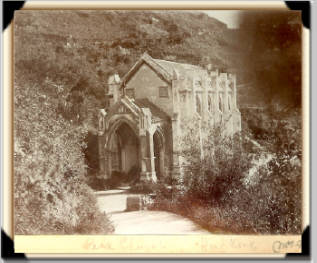
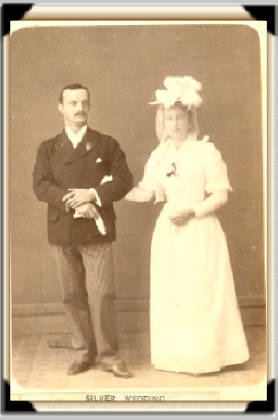
TKD and AMO were married at the Peak Church in Hong Kong on 24 January 1894. There was also probably a ceremony in the RC Cathedral to comply with Catholic requirements. To achieve marriage they must have had to overcome family and religious obstacles as well as practical difficulties. For a start the Oughs were Protestants. Old man Henry was an active Mason and as such would have had pretty firm views about religion. As an actively practicing Anglican he had brought up all his children as Protestants. Anna Margaret certainly taught Sunday School for 9 years The fact that there is a stained glass window erected to old Henry's memory in the Parish Church in East London is a further attestation of his support for his church and adherence to its teachings.
There is also no doubt that the wedding had to be according to RC rites and tenets. TKD would have insisted on that. The RC Church allowed inter-denominational marriages but only as long as the couple agreed that the children would be brought up as RCs. And that is exactly what happened. Frank was born in Hong Kong on 16 May 1895 and Sydney followed just over a year later on 29 August 1896. Both boys were sent to RC run pre- and early schools in the Colony. They both also went later to one of the most religiously strict of the Roman Catholic Schools in England - the Jesuit run Stonyhurst College in Lancashire
My mother Margaret Mary Dealy followed in their footsteps. Born in Hong Kong over 10 years after Sydney on 3 February 1907, she too had a strictly RC upbringing that included a convent in Torquay Devon and the Lycee Jeune Filles in Grenoble. TKD's last will and testament stated “I die a Catholic, the faith of my father and his forbears and wish to be buried according to Catholic rites the third day after my death in a simple and unostentatious a manner as can be.” He also instructed that “My daughter Margaret Mary Dealy is to remain a Catholic and I hope she will practice her religion in the future as fervently as she has in the past.”
The practical difficulties that TKD and his new bride faced were common to those who had to live and work in the distant colonies. I suppose TKD courted AMD during his leaves and then returned to Hong Kong in 1893 engaged to AMD. Whether AMD sailed with him or not as his bride to be is not clear. Perhaps she was chaperoned? Nevertheless they had to find suitable passages and cope with the long sea voyage either separately or together yet apart. They also had to accept the risks of rampant disease, turbulent times and uncertainty of what they would face on arrival. This was particularly so in AMD's case. She was going overseas as a single but betrothed woman to what was for her an unknown country and circumstances. This was all beyond her early experience gained in the comfort and cosseting of a reasonable well off family in civilized England. She was certainly going to marry a man who had already much experience of the orient and who already was well established in Hong Kong circles. Yet she probably would not have known TKD for more than just a few months before consenting to marry him. The one point of reference common to both TKD and AMD was her brother Arthur….. yet he, though living in Hong Kong, was still a bachelor. Quite what the arrangements were for her arrival and preparations for her wedding can only be guessed at, but things could not have been at all easy and much had to have been taken on trust.
The family home at Craigmin East above Magazine Gap was located near the Peak and reflected the social standing of TKD and his family. I have not been able to establish when he bought it, but it certainly remained in his possession after he had left Hong Kong in 1918. It formed part of his estate when he died 1924 and one of the instructions contained in his will is that “After my death none of my investments either in England or in Hong Kong is to be sold nor is my house (Craigmin East Magazine Gap, Hong Kong) to be sold”
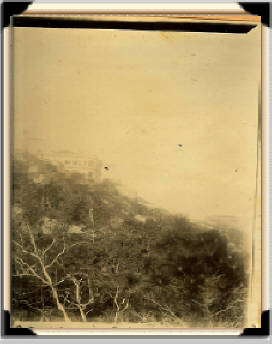
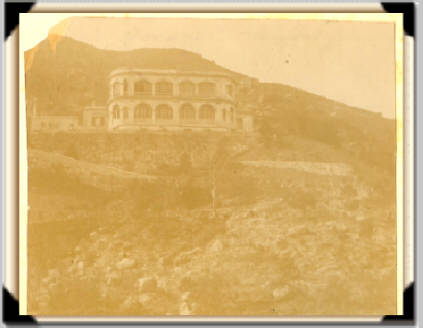

The early married life for TKD and AMD must have been reasonably happy and fulfilling if the photos of that time are anything to go by. There are several pictures surviving from those years before 1914 of AMD. Most are taken in company of her two sons. In these AMD appears content, serene, even happy and it is obvious that she took an immense pride in her two sons. There are some photos of TKD and AMD taken together and most of those that have survived were all made well before my mother was born. These photos are somewhat stilted, typically Victorian - yet do give the impression that the pair were contented together. There is no evidence of the problems that seem to have occurred in later years when they began to live their lives apart. His will does not conceal his feelings in this regard as in reference to his daughter he says “Later when she marries a Catholic herself she should marry a good Catholic mixed marriages are forbidden by the Church and invariably lead to life long unhappiness family dissension and disruption.”
.
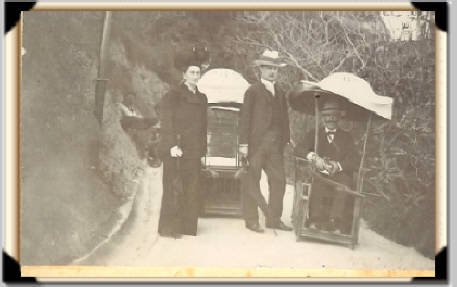
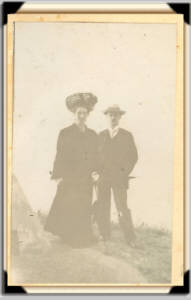
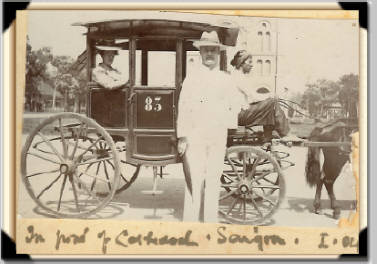
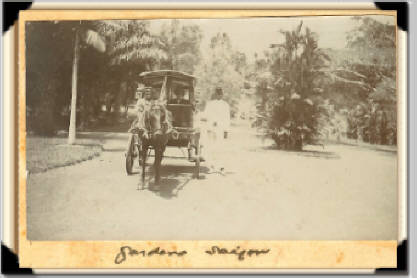
Craigmin East was one half of a semi detached home of two stories perched on the steep slopes of the Peak with a good view of Magazine Gap, Victoria on the Northern coast down below and the fishing village of Aberdeen facing the open sea to the South. It was of the rather ornate yet typically colonial style of those days built of stone and concrete with an ornamental garden. The house was of generous size as it provided accommodation for the family of five plus the retinue of Chinese amahs and house “boys”.There are several photographs of it taken when the family was living there and these illustrate how comfortable a home it must have been. There is no mention anywhere in the records that have come to me of who the neighbours were who lived in what was Craigmin West. Nor is it clear how long the house remained in the possession of TKD's heirs. What is certain is that it was destroyed during the occupation of the colony by the Japanese during World War II. The site is now occupied by a newer, larger mansion.
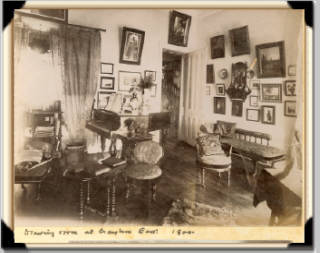
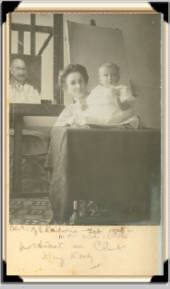

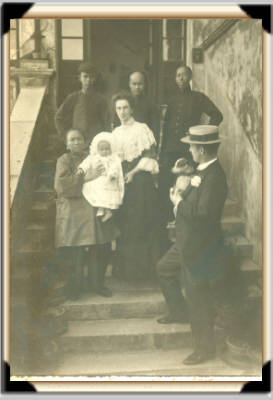
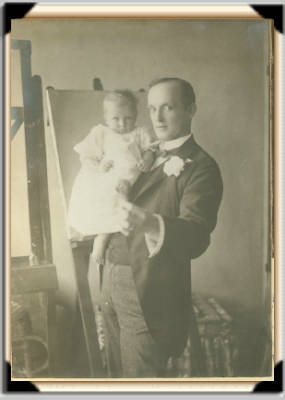
.I have an old sketch map of the Magazine Gap area dated about 1912 that clearly shows where Craigmin East and West were on Craig Min Road. It is not far from the Victoria Hospital where Margaret Mary Dealy was born in 1907. The old hospital building still exists but has been turned into residential flats.
n 1888 the Peak Tram started its operations. This tram…really a cable-car, remained until 1924, the only means of regular transport from Victoria City to the residences on The Peak. Until the road was opened in 1924 the only other ways of making the return journey to the City was by foot or sedan chair. For somebody like TKD who had to attend school every working day, that journey in the early days at Craigmin East must have quickly palled. The climb from Victoria City to achieve an altitude of over 1300 feet must have been long and tedious. Indeed during the rainy season it was not uncommon for coolies carrying sedan chairs to slip and fall loosing themselves, the contraption and their passengers in a tangled heap down the steep slopes of the old pathway. The advent of the cable car service would have come as a great relief.
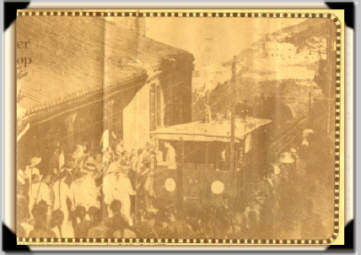
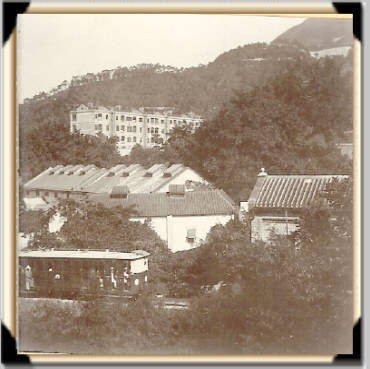
The development of the colony and its education systems was rapid in the years between TKD's marriage and his final retirement in 1918. Several of the largest buildings in Hong Kong were devoted to education. Some of the leading Chinese Residents in the colony had greatly helped in this educational development. The schools were now attracting a relatively large number of students, not only from within the colony but from different parts of China. A newspaper article written in 1918 commented: “These students are the harbingers of a New China and they will one day return to their own land and reflect what they have learned here. The education of these boys is of national importance but ……it calls for patience loyalty and sympathy on the part of those who undertake to provide the education”
During TKD's term as Headmaster two outside events influenced QC - the Chinese Revolution that started in 1911 and the founding of the University of Hong Kong. After several failures Sun Yat Sen's revolutionary party achieved its aim of overthrowing the dieing and corrupt Ch'ing Dynasty - the Manchus


The official British policy during the upheavals in China was not to interfere. The Governor of the time Sir Frederick Lugard was especially strict in this regard. So adamant was he that he even went to the extent of censoring the school 's newly formed debating society for choosing to debate a contentious subject about financial conditions in China. “There is, gentlemen” he said “ample scope in the wide fields of art, of literature, of science and on the topics of the day from which to choose subjects for debate without encroaching upon politics, religion and racial antipathies”.
Although the school tried to keep itself unaffected by outside events the revolution did cause change. Most obvious and immediate was the disappearance of the queue….apparently these disappeared almost overnight. The upheavals on the main land affected the lives of many pupils. Abduction was the cause of much of the prolonged absences during that time. It was quite common for boys returning home for holidays to be kidnapped and held to ransom. One letter received by TKD read:
9 April 1917
Sir,
Having received the awful tidings that Cheuk Yuk Ling and Cheung Yuk Tat have been both kidnapped by thieves when visiting their ancestor's graves. I beg you to kindly grant them a few days absence as they will be ransomed in a short time. As soon as they are freed they will attend to school.
Yours truly,
F.S.Tong
Another written a year earlier read:
Dear Sir,
I beg to inform you that my son U Wing Piu returned to our native village to worship tombs during the Ching Ming holidays. Owing to the Declaration of Independence by the Canton Government the country is in a very disturbed state, launches and ferries have suspended business and Wang-Piu is unable to return to Hong Kong. I shall therefore feel obliged if you will kindly grant my son leave of absence until such time as travelling in the interior is safe and boats have resumed their normal run.
Yours respectfully,
U Yan Po.
These two examples provide a tiny window on what must have been years of considerable disruption and turmoil both for the school and TKD himself. First there was the revolution in China that went on and on interminably and then there was the war in Europe. The latter affected him personally and must have been a great worry, especially with his close family so far away and for his two sons to be committed and lost towards the end.
TKD packed much into the 24 years he and AMD shared in Hong Kong. For some time, in addition to his teaching duties at Queen's College he was also Master in Charge of the Police School. In 1906 he was appointed Second Master at QC becoming Headmaster three years later in 1909. In that year he was also Acting Director of Education and again in 1914. He was Cable Censor as well and had been an official Justice of the Peace since 1904. The latter appointment was made by the then Governor of the Colony
TKD was evidently not given to socializing and was reputed to be a man of temper and of few words when in company of people who did not hold his more serious views on life. He spent much of his time studying and apparently regarded books as “his greatest friends”. He is reputed to have often gone into the less savoury parts of Hong Kong in search of curios and opportunities to learn more of the vernacular. His library in Craigmin East was said to be one of the best in the colony. He had studied Chinese from the time of his arrival in 1884 and became a fluent conversationalist in Cantonese, with an extensive knowledge of Chinese characters. He contributed to the “China Review” and also revised and enlarged Chalmers' Cantonese Dictionary. His knowledge of things Chinese and of Chinese literature was extensive and he translated over 700 poems written in the Tong times and during the Sung dynasty.
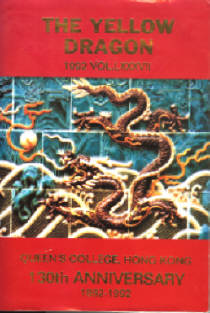
TKD took professional and emotional interest in the school life and for sometime edited the School magazine, "The Yellow Dragon". He also contributed much material for the magazine including reams of poetry of which the two stanzas at the start of this chapter are an example. Doubtless the propensity for poetry was inherited by elder son Frank and reinforced for him by the standard set by his father
He found time to study and become fluent in modern languages including Russian and French. He in fact visited both countries in 1916. The school magazine records that he went on home leave in April 1916 via Siberia a route that was then popular as it took a shorter time than going through the Suez Canal.
But just how he managed the trip and its actual timing is a mystery. Whilst the school magazine records his journey as taking place in 1916, MMD's personal record is that it took place in 1917. Both countries were in the middle of the first World War and things were certainly not going well for either of them, but especially Russia. TKD's visit must have preceded the October revolution of 1917 by just a few months and the conditions in the country during his visit must have been in some places dire indeed. Both his sons had by then left Roseworthy College in Australia and had joined up in November 1916 to fight on the Western Front with the AIF. Perhaps he went on leave first to Australia and then took advantage of the Trans Siberian Railway to travel across Russia and get to France and possibly England. It is certain that he visited friends in the Russian City of Novgorod - the Romanoffs (no relation of the Tsars family!) (Insert photo). His trip may have enabled him to contact both his sons in Australia before they embarked but that would certainly have been the last time he saw either before they were lost. Maybe also it was during his time in France that he started to make his plans to retire to the University of the City of Grenoble.
Unfortunately there is no record to shed light on his movements or the reasons for his journeying in either 1916 or 1917.
He managed to find time to live the life of a married man with his family, especially in the first sixteen years of his marriage. His two sons were born soon after his marriage and probably spent their early childhood in the colony. But they were sent to Stonyhurst College in Lancashire as borders in 1905. The school record indicated that he had been on extended leave in the previous year but had been home only twice in the preceding 19 years. Perhaps it was during his leave in 1904 that he made the arrangements for the schooling of his sons and took them to the UK with him. Their departure must have meant that he and AMD rarely saw either son during their years at school after 1905. There would have been opportunities during home leave periods but these trips would have been relatively infrequent. It is certain for example that he took home leave in 1910, but not again until 1916. Perhaps he was able to send AMD home more often, but that would have been constrained by cost and opportunity as well as the fact that Margaret Mary was born to the couple in Hong Kong in 1907.
Sometime during the years after MMD was born things must have started to go wrong in the relationship between TKD and AMD. It is certain that in 1912 his older son, followed by Sydney the younger left Stonyhurst and joined the Agricultural College of Roseworthy in South Australia. Just how this came about is not on record. Perhaps they went there of their own volition later to be joined by AMD and Margaret Mary or maybe AMD and TKD had already decided to live apart and the separate home at 35 Brougham Place in Adelaide had been set up to provide a base for the boys. At any rate it is certain that separate lives were embarked on at that time and the pair appear to have remained separated for most of those years until 1918 and after the war. Perhaps it is the circumstances that lead to this period of apparent disharmony that prompted his rather bitter sentiment that “Catholic mixed marriages are forbidden by the Church and invariably lead to life long unhappiness family dissension and disruption.”
However, they must have spent time together and in Hong Kong. There is an entry in the school magazine for 1913 to the effect that: “ Wen Tsung Yao commissioned Mrs Dealy, a capable artist, to paint a portrait of her husband for presentation to Queen's College.”
What happened to the portrait is not known, but it had to have been painted in Hong Kong.
Another factor that had required the couple to live long periods apart was the need to send MMD to competent medical care to correct a posture problem. Evidently MMD suffered from one leg being shorter than the other and treatment needed an extensive stay in a hospital were the expertise was available. So MMD, accompanied by her mother was sent to the Royal Paediatric Hospital (check name) in Adelaide. The year she was sent is not on record but would have been when she was about 7 or 8 years old, i.e. 1914 or 1915. At any rate MMD and her mother lived from then until 1918 in Adelaide at 45 Brougham Place.
The home in Adelaide may have been owned by TKD. An entry in his will suggests that…. “After my death all the furniture and effects, books and jewellery trinkets curios bronzes paintings framed and unframed in the apartment at 19 rue Voltaire Grenoble shall remain in the home until departure for Adelaide is decided on when due selection of boxes pictures bronzes curios and ornaments having been made for the home in Australia.”. However, the fate of that house, like that of Craig Min remains a matter for conjecture.
.
As an interesting aside the James Cavell novels Noble House and Taipan are apparently based on the "Princely House" of Hong Kong- Jardine Matheson and Co., Ltd. The founder of that house (William Jardine) was the architect of the acquisition of Hong Kong and the Opium War of 1838-40. He founded his firm by obtaining huge profits on opium. He was called "The Iron Headed Old Rat", and was renowned for his cleverness. The prominent Hong Kong Eurasian Ho family were the historical compradores of the “Princely House” through the 1800's and 1900's and are understood to still own an interest in the firm.
One of these compradores was Sir Robert Ho Tung who in later life became very famous. His blue but slanted eyes and red hair confirmed his status as a Eurasian. His link to the Jardine family has been speculated about, but he was educated at Queen's College. He left the school in 1878 to join the Chinese Maritime Customs service. In 1880 he left that service and joined Jardine Matheson and Company. Later, much later, he became linked strongly to the promotion of Dr. Sun Yat Sen's new ideas on the Govt. of China. Sir Robert Ho Tung went on to become a multi millionaire with many philanthropic and educational interests. It is clear from the records that he was much respected and revered as a man of substantial and beneficial influence within HK and beyond its confines. He was responsible for the foundation of the King George V School in Kowloon in 1902. When he died in 1953 he left $500000 to the Sir Robert Ho Tung Foundation that was dedicated to funding charitable activities, especially related to hospitals and health. He left behind a library that still exists in Macao.
But the main interest to this chapter is that RHT presented TKD and AMD a silver bowl engraved with the words “ To Mr and Mrs Dealy on their departure from HK from their old friend RHT”. That bowl is still in my possession. Who knows how that friendship was first struck up. TKD and RHT were of the same generation and no doubt RHT was prominent in his support for the development of QC especially during TKD's time there. RTH was also responsible for helping set up the Old Boys Association and was its first President. The Association, a support group for the school, still exists to this day
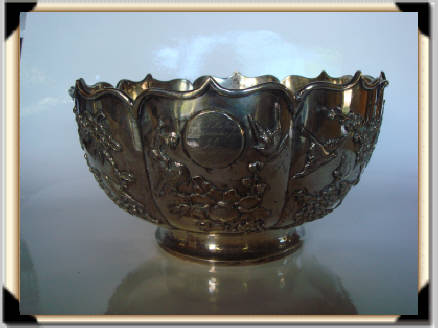
At any rate the friendship with RHT does suggest that TKD was not a studious recluse or entirely aloof. Nor did he keep apart from the Chinese community as has been suggested. He may have had few real friends in Hong Kong, but those he had he retained and were of the highest calibre.
TKD was not a popular Headmaster or within the wider colonial society. In fact he was described as a difficult person in the official colonial records and a disciplinary case was referred to the Colonial Office in London by the Governor of the time. His unpopularity with the local colonials and the government was more than likely caused by his sympathies for the local Chinese and his friendships and contacts with prominent Chinese citizens and residents. These would most certainly have not gone down well with the colonial officials and society at large. But he was a man of strong principles and standards who could not stand fools easily nor the hypocracies of the time.He was much in advance of the times and to be admired. He left a legacy of good in Hong Kong which lives on in Queens College.
TKD finally retired in May 1918. His departure was described as a “ veritable uprooting”. He had been at the school since December 1884 - more than 33 years. The Colonial Secretary Mr. Claud Severn said at the annual school prize giving: “ I should like to refer to the great loss Queen's College is shortly to experience in the retirement of your Headmaster, Mr Dealy, from the Public Service. His is a wonderful record. He acted as Second Master nearly 28 years ago and for the past nine years has been Headmaster. The pupils who have passed through his hands must number many thousands of the inhabitants of this colony. His teaching must have had a great influence in shaping the lives and characters of many of the most prominent men in business and professional life of Hong Kong. It has been your life's work Mr Dealy, and I am sure you can look back on it with pride and pleasure. I can confidently assure you that you will carry with you into your retirement the best wishes of the Government you have served as well as that of the generations of scholars whom you have trained within these four walls.”
The year he retired was a very tough one for TKD and AMD. Not only were they living apart for much of the time, but hardest of all to bear was the loss of Sydney in March 1918 in Ayrshire in Scotland and then Frank on the Somme in August 1918. TKD was most likely in Hong Kong when news of Sydney was received. Where he was when news of Frank came through is harder to judge. By then he may still have been in Hong Kong living on his own in Craigmin or may be he had joined AMD in Adelaide. There is no record. Nonetheless those events and the worry of making arrangements for his retirement must have weighed heavily on him.
The following two years were times of upheaval for the now sadly reduced family of TK and AM Dealy. Thomas left Hong Kong sometime after his official retirement in May. He may have joined Anna May and Margaret in Australia before moving to England. Alternatively TKD may have found his own way “home” leaving Anna May and Margaret to join him in Torquay. At any rate it is clear from correspondence by postcards from him that year that the family had moved to the home of Henry and Anna Barthelemew Ough at 2 Sherwell Terrace, Chelston in Torquay.
As a young Catholic Margaret was sent to a school run by Sisters at “The Knoll” in Torquay. This was “The Convent de Les Filles de La Croix”. Whether she went as a border or simply attended daily is not clear, but certainly the family stayed with the Oughs for the better part of 1919.
Henry and Anna Ough provided a centre of stability and sanity not only for the small Dealy family but also other members of the Ough clan throughout the turbulent years of the War and its aftermath.
By the time Anna May, Thomas K and Margaret returned to England in 1919, Arthur Ough was married with a family of his own at Esk Hall in Northeast Yorkshire. Marion had also married Norman Gibson and was living with her engineer husband at The Arsenal in Woolwich, London. Sydney William a mining engineer had also married and after escaping from the 1914 Revolution in Mexico had brought his young family back to England and was also working at The Arsenal. Amy, as yet unmarried, was working as a hospital nurse in London.
There was also TKD's own family of relatives in Sheffield. But it is evident from the scrappy records that remain (also family rumours that persisted through three generations) that Thomas had quarrelled with his brother Henry and the resulting bad relationships were never subsequently repaired. The contacts with the Dealy side of the family in the event turned out to be difficult at first and apparently highly problematic in the years following the Great War.
AMD and TKD must have returned to England for a variety of reasons. But probably the strongest incentive for AMD was to search for consolation and support for herself in the bosom of the Ough family. She still needed to find salves for the hurt of her devastating losses. Yet she also had to find the spirit and the energy to support her also grieving husband and to look after and provide for her remaining child Margaret.
Thomas too was trying to find a course, a way ahead. Although he had retired from the Hong Kong education service he was still only in his late fifties. Reasonably well off he still had to find a new career and establish a home for his family. He faced these problems at a time of great upheaval and turbulence. The war had left Europe devastated and many countries in a state of ruin. As an expatriate with a long period of colonial service he was to find England populated by exhausted people with little patience or understanding for someone who had been away from home for so long. The problem was not so much with the immediate family in Torquay and London. Rather it was probably with the authorities to which he may have applied for work as an educator. His experience as master and headmaster of a distant colonial school and one mainly for Chinese was hardly likely to attract prospective employers in England.
Yet despite all the recent trauma and dreadful blows, he still had the energy and the spirit to find a new future for himself and his family. He still found time to show his affections, to look ahead and carry on with life. The sad events of 1918 may also have served to bring him closer to AMD and a resolve to repair their relationship.
TKD travelled through France in 1919 to search for his son Frank's grave and make arrangements for settling in Grenoble. In fact Thomas is silent on that aspect and leaves no record of his feelings. It must have been a sad journey for a man who had spent so many recent years alone separated from his family and especially his two sons for whom he had done and cared so much.
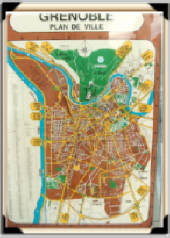
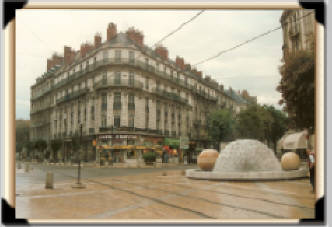
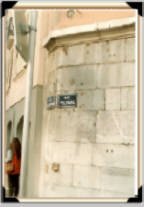

The mystery for me was the decision to go to Grenoble. Was it simply just a case of going there because that was where he could get work, or was there something more? It seems extraordinary that he chose to leave England, the base for his wife's extended family and where so much loving support was available, to go to France where there was no family, few friends and to a city which neither he or Anna May had previously lived. It maybe that during his trip to France in 1916 he had visited Grenoble and made the contacts he needed for later retirement. But the final decision was almost as if he wanted to get away from England and things English to immerse himself in the culture and habits of a quite different place.
Another unanswered question is why did they leave and apparently cut themselves off with such finality from Australia where he and his sons had invested so much? Maybe it was the bitterness of the loss of sons through the Australian Imperial Forces and the consequent need to escape from anything associated with the “lucky Country”. At any rate, there are hardly any records of further contacts with Australia after 1919 and the forlorn memories of life at Brougham Terrace.
At any rate, live in Grenoble he did with his wife and daughter from 1919 to 1924. Their flat at 19 rue Voltaire was near the City Centre and the University in the older part of town. I saw the place during my visit 63 years later in 1987 and I expect it was not much changed from the days when they lived there. It is close to a central park and MMD's old school.
Situated in the French Alps Grenoble is a gracious University City and a centre for advanced technologies including nuclear energy sciences. The River Isere runs through it and the railway and highway provide excellent travel connections to the rest of the country. The attractions of a continental climate with drier hotter summers and colder but whiter winters than the UK may have had much to do with the decision to live there. At any rate, the family evidently enjoyed living in Grenoble and took advantage of the closeness of the Alps for rambles, walks, skiing. AMD also did a lot of painting. Mainly landscapes in water colours, she left behind a lovely record of those times.
TKD's work at the University worked as a translator and tutor of English. The actual title of his job is not on record.
TKD left behind one book he actually used for his work as a translator. It is Rudyard Kipling's “The Days Work” and was bought by TKD in January 1921. It is heavily annotated with his pencilled notes interpreting the English idioms and slang words that Kipling used throughout the book. Most of the notes are in English but he also used French and even some Chinese characters. Perhaps the latter were only for his own benefit! Maybe the book was one prescribed as part of the course of study for his students, and he used it for his lectures or tutorials…….even if it was not for that pedagogic purpose and was just a private exercise for himself, this relic from his time in Grenoble is an intriguing remnant and somehow brings the man closer than all the other memorabilia he left behind. The writing for the most part is cramped and hard to read. But the notes indicate an active, enquiring mind and a meticulous approach. It would have been a very hard job to explain and interpret Kipling's use of vernacular and slang English with many Indian colloquialisms to students used to another language.
TKD suffered increasingly from headaches and melancholia in his final years. It seems that a blow on the head from a cricket ball in his youth was the cause of a brain tumor and the source of his problems. At any rate he entered the local hospital in March 1924 to have the tumour removed but did not survive the operation. One has to wonder what he would have thought of the fate of the legacy he left behind and whether in the end he found the peace that he did not always have in life.
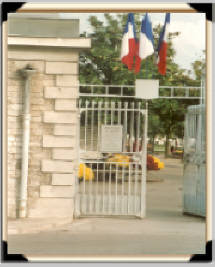
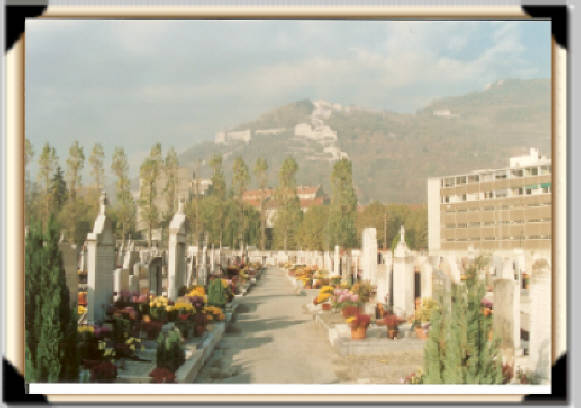
This is the Last W ill and Testament - of me-
THOMAS WILLIAM KIRKMAN DEALY
Formerly (from October 1884 to July 1918 of the Hong Kong Civil Service and now of 19 rue Voltaire Grenoble (Isere) France. I die a Catholic, the faith of my father and his forbears and wish to be buried according to Catholic rites the third day after my death in a simple and unostentatious a manner as can be. I APPOINT my wife ANNA MARGARET DEALY sole EXECUTRIX AND TRUSTEE of my Will. In the event of remarriage my widow shall cease to act as Executrix and Trustee of my will and at the same time forfeit all benefits under my Will. THE PUBLIC TRUSTEE shall thereafter administer my Will. After my death none of my investments either in England or in Hong Kong is to be sold nor is my house (Craigman East Magazine Gap, Hong Kong) to be sold and my share of one third of my deceased father's estate in Sheffield when realized should be invested in South Australian Government Stock and the script therefore deposited along with my other script at the London Branch of the Hong Kong and Shanghai bank 9 Gracechurch Street EC 3. The regular income from my investments in Hong Kong and in England from my home in Hong Kong and the moneys received from the Trustees of my deceased father's estate in Sheffield while still unsold shall be used by my wife as income during her life. After my death all the furniture and effects, books and jewellery trinkets curios bronzes paintings framed and unframed in the apartment at 19 rue Voltaire Grenoble shall remain in the home until departure for Adelaide is decided on when due selection of boxes pictures bronzes curios and ornaments having been made for the home in Australia. What remains is to be sent for sale at Public Auction and the process placed to credit the Estate current account. My daughter Margaret Mary Dealy is to remain a Catholic and I hope she will practice her religion in the future as fervently as she has in the past. Later when she marries a Catholic herself she should marry a good Catholic mixed marriages are forbidden by the Church and invariably lead to life long unhappiness family dissension and disruption. After my death my wife shall continue to live in Grenoble until the completion of the education of my daughter Margaret Mary Dealy such completion to mean the taking of the first and second part of the Baccalauret in the fifth and sixth classes respectively a the Lycee Jeune Filles . After this my wife and daughter shall return and settle in Adelaide South Australia. When my daughter Margaret Mary Dealy reaches the age of twenty one - she was born 3 February 1907, my wife out of the income from the estate is to allow her 10 shillings per week as pin money payable in quarterly instalments of six pounds ten shillings to be paid on her twenty first birthday 3rd February 1928. My daughter Margaret Mary Dealy in Grenoble and later in Australia shall continue to live at home with her mother until her own marriage or until her mother's death. After my wife's death the income from my whole estate is to be paid to my daughter Margaret Mary until she is thirty years of age when my whole estate is to become hers absolutely. If my wife lives beyond 3rd February 1937 when my daughter Margaret Mary will be thirty years of age then the estate will not pass to my daughter until her mother's decease but in this case from the time my daughter is of thirty years of age she shall receive one third of the total income from my estate the other two thirds of the total income to be enjoyed by my wife until her death when the whole estate shall pass absolutely to my daughter Margaret Mary. When the whole estate does fall to my daughter Margaret Mary I advise her not to sell either the house in Hong Kong or the investments there. The Oil Shares (English investments should be sold at a fitting opportunity and the proceeds invested - I suggest only - in South Australian Government Stock. The London branch of the Hong Kong and Shanghai Bank ( 9 Gracechurch Street E.C.2) who hold the script in safe custody would speedily put these transactions through for her. I HEREBY REVOKE all former Wills made by me at anytime heretofore in witness whereof I the said Thomas William Kirkman Dealy have to this my last Will and testament set my hand this fourth day of January One thousand nine hundred and twenty four.
THOMAS WILLIAM KIRKMAN DEALY
Signed and acknowledged by the above named Thomas William Kirkman Dealy as and for his will in the presence of us both being present at the same time who in his presence and in the presence of each other have at his request hereunto signed our names as witnesses R.G. SWANNELL 3 Place Malakoff Grenoble France Manager of Glove Factory …W.G. MORRIS 19 rue Diderot Grenoble France assistant Manager of Glove Factory.
Affidavit filed that deceased was a British Subject that he made his will in France and that his domicile of origin was English . Signed PG Bramwell
Grenoble 11 July 1924 . this is the probate of the last WILL AND testament of Thomas William Kirkman Dealy, my husband referred to in my affidavit of this date relative to the inventory of his Personal Estate. Signed A.M. Dealy and and official PG Bramwell
Three stamps complete the document plus the following statement:
Edinburgh 6th August 1924 recorded in the Court Books of the Commisseriate of Edinburgh conform to Act of Parliament by AB Pitrie
Copyright of all parts of this site is owned by M.& M.M. Ough Dealy
This page last modified on Sunday 18 July, 2021